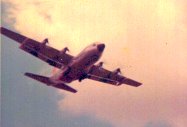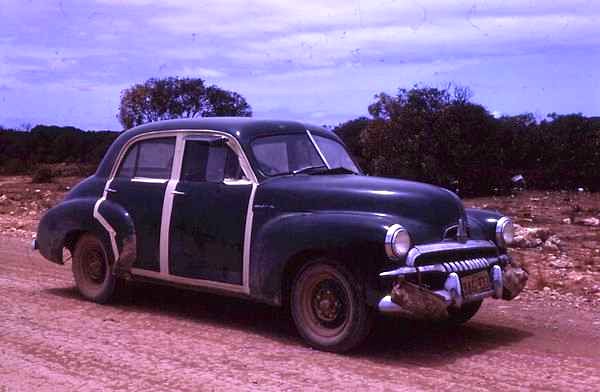|
|
||
|
|
Radschool Newsletter |
Vol 12 Page 8 |
|
|
||
|
RAAF Richmond to Perth trip - December 1964
Ted McEvoy remembers the nightmare that used to be known as the “Nullarbor Crossing”. Back in the mid 60’s, to cross the Nullarbor was like walking on the moon—and if you did it you were looked upon with awe. His recollections are sure to bring back a lot of memories….. Ted says:….
Towards the middle of 1964, Tom (Tich to us Appies) Harrington and I decided we’d take the BIG adventure and drive from Richmond to Perth for Christmas. Tom was originally from Broken Hill and I was from Perth.
We had both joined the RAAF on 8th February 1960 as part of 14 (Apprentice) Course based at Frognall. I was a bit disappointed at first as I thought I was joining the Air Force – where was the runway and where were all the aircraft??? I wanted to smell burnt kerosene from jet aeroplanes and not the stench of brown briquettes from pot-bellied heaters. (But that is another story).
Ted in his hay-day, tripping the light fantastic at one of the organised dances during his stay at Frognall.
Following our graduation in late 1962
as AC Radio Technicians (Air), the RAAF decided that because we got
through our apprenticeship it follows that we must now know
everything about our trade so Tom and I were posted to
"A" model Herc, on finals at Richmond
The next year (1963) I purchased my 1956 FJ Holden – and a modern technological marvel it was. After a while, I had fitted some luxury extras such as:
A seal can sleep underwater and surface for a breath of air without waking up.
An extract from my “Useless Pieces of Info” book. I’ve always remembered the size of the standard tyres on the FJ and the VW Beetle as being 5-60-15’s as this is the same as my RAAF Service Number – A56015. It that spooky or from the X-files or what???
My great old FJ was affectionately known as “Mac’s Modern Miracle” (at one stage I was considering taking legal action against the 3M company as I reckon I had the abbreviation all stitched up with MMM). The FJ stayed with me until 1967 when I traded it in to buy a Datsun Fairlady 1600. When the car salesman offered me a trade-in value of 25 pounds, I had a big spit and he said to me “Listen mate, I can go to the Flemington car auctions and pick up half-a-dozen FJ’s for 25 quid. Take it or leave it." I took the 25 quid.
The mighty FJ, taped and ready for work.
Anyways, Tom and I planned for the big adventure to the West. We boned up on all the hints and tips to cross the Nullarbor. We loaded up the FJ with 2 spare wheels and tyres, spare fan-belts, water hoses, points, plugs, jerry’s of water and fuel, 4 gallons of oil and an esky or two. Two water-bags hung from the front bumper-bar – we looked the part and we were ready - we set off on a Friday after work at Richmond (1650 hours precisely).
We travelled through the night to Adelaide via the Hay Plains – not my most favourite part of Australia. We eventually got into Adelaide after 19 hours on the road and had a bit of a zuzz on the banks of the mighty Torrens River. We visited Tom’s uncle and aunt during the day and sponged a nice meal off them. We stayed that night in a motel at the base of the Adelaide hills – the soft beds and the hot shower went over a treat.
Answer-phone message “…..and if you want to buy marijuana, press the hash key...."
Sunday morning we’re up and off – over the Adelaide hills through Mt Barker, Hahndorf to Murray Bridge and then onto Port Pirie and Port Augusta. On the way we briefly stopped at Port Germain to have a sticky at the jetty which seemed to poke out forever into the Gulf – the water is so shallow.
We had a bit of a break in Port Augusta while we prepared the FJ for the Nullarbor crossing. One tip we had read, was to use masking tape to seal all the door and boot openings to help reduce the amount of bulldust entering the vehicle. We left the passenger’s door free to allow us entry to the vehicle. We thanked the painters at Richmond who donated the masking tape as we bandaged up the old FJ (see picture). “That’ll do the trick” we thought.
Leaving Port Augusta, we took the road which leads to Whyalla (why not I say). Just before the (then) El Alamein army camp – now it’s a Refugee Centre, is the turn off to the right which is the start of the mighty Eyre Highway, at which point the bitumen gave way to dirt. Apart from some bitumen in the town of Ceduna, the next bitumen we travelled on was a good 1,000 miles (1,600Kms) away.
Approx 25 miles along the dirt, we had to pull over as the old FJ was overheating. I popped the bonnet and Tom pulled the radiator cap off too quickly and, whoosh, up it went. Luckily, he wasn’t burnt and fortunately all the gunk in the radiator and the cooling system was blasted out– should have got the radiator cleaned before we left Richmond – sigh….
The interesting Nullarbor countryside??? and the road as she was—it’s been a long time since anyone has had to drive on this type of surface….
After refilling the radiator with fresh water, we were back on the road again. We ripped through places such as Kimba, Wudinna, Poochera and onto Ceduna for some refreshments and fuel. At the Petrol station we asked the owner if he sold ice. “Yep.” he says. “Do you want block or crushed?”. I replied “We’ll have crushed, please”. He comes out with a big block of ice in a hessian bag resting on his shoulder. I thinks to myself “That ain’t crushed ice – that’s a block”. Before I have time to start bitching, he grabs hold of the neck of the bag, and in a quick circular motion, smashes the bag onto the concrete driveway. “There you go.” he says to me, “Crushed ice”.!! I button my lip and poured the crushed ice into our eskies.
Back on the road. The masking tape job we had carried out on the vehicle was good in theory but useless in practice. I hadn’t realised that the floor of the FJ was pocked with small rust holes so that, every time we drove over a patch of bulldust, it was like a hundred little atomic bombs of bulldust going off in the car.
If all the world is a stage, where does the audience sit?
We soon realized that it was much more comfortable and cooler to partly lower the rear windows to get some airflow through the car and blow some of the bulldust away. When travelling on the old, dirt road I discovered that the best time to travel on it was just after the grader has been through – the road was in better nick after being graded. When we travelled on the road in 1964, I’m unsure when it had last been graded as the general condition of the road was bloody awful.
Interesting story about the grading team – the job was a bit like painting the Sydney Harbour Bridge – once you finished painting it you started all over again. There were 3 graders in a team and each towed a caravan behind them. The 3 graders were spaced apart - approx 100 meters between each grader. The first grader occupied the left-hand side of the road, the next one the middle and the third grader tarted up the right-hand side. They graded/scraped all day and pulled over at night. I can recall at least one other support vehicle accompanying the team which was the fuel tanker. A lonely, dusty existence but these blokes never had to drive through peak-hour traffic to work – they were always at work.!! The famous Len Beadell in his books, describes similar activities when he and his team created the Gunbarrel Highway as part of the rocket testing in the late-50’s. The Poms were based at Woomera and were conducting flight tests of their rockets (were they called Blue Steel???). After the fuse was lit, it’d blast off and land somewhere in remote Western Australia hopefully at the end of Len’s road but not on his head!!
The Nullarbor is comprised mainly of limestone which can be a mongrel to drive on. Long stretches of corrugations meant that we had to travel at sufficient speed to get on top of the corrugations but not too fast as to prevent a quick stop when we came across huge potholes or the numerous cattle-grids. Even though we had good (for those days) tyres on the car and even with the superb braking ability of the FJ, we made quite a few panic-stricken emergency trips into the bush on the side of the road. It sure gets the adrenalin rushing through the body. We never flipped the FJ but she rocked-and-rolled a couple of times (please don’t let my mum read this yarn).
The road also had huge patches of bulldust – sometimes it was like driving into a rainstorm – the dust would fly up in front of the vehicle and we couldn’t see a bloody thing. We’d hope like hell that there was nobody coming the other way”,
Ted’s story continues next issue
|
||
|
You know you’re living in Sydney when your hairdresser is straight, your plumber is gay and your Avon Lady is a drag queen. |
||
|
|
||
|
|
||
|
|
||
.jpg)



